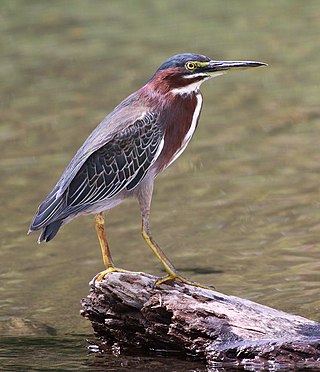
The green heron is a small heron of North and Central America. Butorides is from Middle English butor "bittern" and Ancient Greek -oides, "resembling", and virescens is Latin for "greenish".

The Acadian flycatcher is a small insect-eating bird of the tyrant flycatcher family.

Russula virescens is a basidiomycete mushroom of the genus Russula, and is commonly known as the green-cracking russula, the quilted green russula, or the green brittlegill. It can be recognized by its distinctive pale green cap that measures up to 15 cm (6 in) in diameter, the surface of which is covered with darker green angular patches. It has crowded white gills, and a firm, white stipe that is up to 8 cm (3 in) tall and 4 cm (1.6 in) thick. Considered to be one of the best edible mushrooms of the genus Russula, it is especially popular in Spain and China. With a taste that is described variously as mild, nutty, fruity, or sweet, it is cooked by grilling, frying, sautéeing, or eaten raw. Mushrooms are rich in carbohydrates and proteins, with a low fat content.

Micrommata virescens, common name green huntsman spider, is a species of huntsman spiders belonging to the family Sparassidae.

The singing honeyeater is a small bird found in Australia, and is part of the honeyeater family Meliphagidae. The bird lives in a wide range of shrubland, woodland, and coastal habitat. It is relatively common and is widespread right across Australia west of the Great Dividing Range, through to the west coast and on Western Australian coastal islands. It does not occur in other countries.

Pseudoharpax virescens, common name Gambian spotted-eye flower mantis, is a species of praying mantis native to western, central and eastern Africa. It takes its name from two eye spots on the dorsal side of the abdomen of adult females.
Anomiopus is a genus of scarab beetles in the family Scarabaeidae. There are more than 60 described species in Anomiopus, found in Central and South America.
Anomiopus ataenioides is a species of true dung beetle that is endemic to northern Argentina, and is known from Salta, Jujuy, Tucumán and Corrientes provinces. It is believed to share ant colony nests (myrmecophile).
Anomiopus birai is a species of true dung beetle that is known from Caaguazú and Concepción departments of Paraguay, and Mato Grosso do Sul and Mato Grosso states of Brazil. It is found in cerrado savanna at low altitudes, and is a myrmecophile.
Anomiopus bonariensis is a species of true dung beetle that can be found in Argentina, Brazil and Uruguay. It is a myrmecophile, and has been recorded living in nests of Acromyrmex lundii.
Anomiopus idei is a species of true dung beetle that is endemic to Perú, and is only known from its type locality in Loreto Region.
Anomiopus lacordairei is a species of true dung beetle that is endemic to French Guiana, and is only known from Cayenne. It has been recorded from lowland forests, and it may be a myrmecophile.
Anomiopus laetus is a species of true dung beetle that is endemic to Brazil, and is known from Amazonas, Pará and Acre states. It may be a myrmecophile.
Anomiopus nigrocoeruleus is a species of true dung beetle that can be found in Argentina, Brazil and Paraguay. It can be found in cerrado and chaco biomes. It may be a myrmecophile.
Anomiopus parallelus is a species of true dung beetle that can be found in northern Brazil and French Guiana, and can be found in the Amazon and Cerrado biomes. It may be a myrmecophile.
Anomiopus pictus is a species of true dung beetle that can be found in Brazil and Perú. It may be a myrmecophile.
Anomiopus smaragdinus is a species of true dung beetle that can be found in Brazil, French Guiana, Venezuela and Bolivia. It may be a myrmecophile.
Anomiopus soledari is a species of true dung beetle that is endemic to Brazil, and can be found in the Federal District and Goiás State. It can be found in the cerrado biome, and may be a myrmecophile.
Anomiopus gracilis is a species of true dung beetle that can be found in Brazil and Venezuela.
Anomiopus howdeni is a species of true dung beetle that can be found in Brazil and French Guiana.






